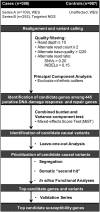A region-based gene association study combined with a leave-one-out sensitivity analysis identifies SMG1 as a pancreatic cancer susceptibility gene
- PMID: 31469826
- PMCID: PMC6742418
- DOI: 10.1371/journal.pgen.1008344
A region-based gene association study combined with a leave-one-out sensitivity analysis identifies SMG1 as a pancreatic cancer susceptibility gene
Abstract
Pancreatic adenocarcinoma (PC) is a lethal malignancy that is familial or associated with genetic syndromes in 10% of cases. Gene-based surveillance strategies for at-risk individuals may improve clinical outcomes. However, familial PC (FPC) is plagued by genetic heterogeneity and the genetic basis for the majority of FPC remains elusive, hampering the development of gene-based surveillance programs. The study was powered to identify genes with a cumulative pathogenic variant prevalence of at least 3%, which includes the most prevalent PC susceptibility gene, BRCA2. Since the majority of known PC susceptibility genes are involved in DNA repair, we focused on genes implicated in these pathways. We performed a region-based association study using the Mixed-Effects Score Test, followed by leave-one-out characterization of PC-associated gene regions and variants to identify the genes and variants driving risk associations. We evaluated 398 cases from two case series and 987 controls without a personal history of cancer. The first case series consisted of 109 patients with either FPC (n = 101) or PC at ≤50 years of age (n = 8). The second case series was composed of 289 unselected PC cases. We validated this discovery strategy by identifying known pathogenic BRCA2 variants, and also identified SMG1, encoding a serine/threonine protein kinase, to be significantly associated with PC following correction for multiple testing (p = 3.22x10-7). The SMG1 association was validated in a second independent series of 532 FPC cases and 753 controls (p<0.0062, OR = 1.88, 95%CI 1.17-3.03). We showed segregation of the c.4249A>G SMG1 variant in 3 affected relatives in a FPC kindred, and we found c.103G>A to be a recurrent SMG1 variant associating with PC in both the discovery and validation series. These results suggest that SMG1 is a novel PC susceptibility gene, and we identified specific SMG1 gene variants associated with PC risk.
Conflict of interest statement
The authors have declared that no competing interests exist.
Figures





References
-
- Roberts NJ, Klein AP. Familial Pancreatic Cancer In: Neoptolemos JP, Urrutia R, Abbruzzese JL, Büchler MW, editors. Pancreatic Cancer. New York, NY: Springer; New York; 2018. pp. 553–72. (Pancreatic Cancer).
Publication types
MeSH terms
Substances
Grants and funding
LinkOut - more resources
Full Text Sources
Medical
Miscellaneous

